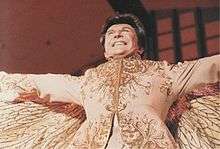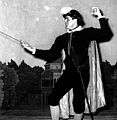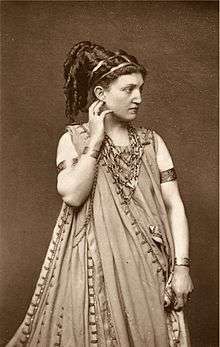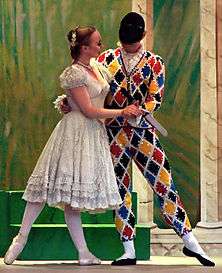Stage clothes


| Part of a series on |
| Costume |
|---|
 |
|
Background
|
|
Society and culture |
|
Elements and methods |
|
Children |
|
Fictional |
|
Organizations |
|
People
|
|
Museums
|
Stage clothes is a term for any clothes used by performers on stage. The term is sometimes used only for those clothes which are specially made for the stage performance by a costume designer or picked out by a costume coordinator. Theatrical costumes can help actors portray characters' age, gender role, profession, social class, personality, and even information about the historical period/era, geographic location and time of day, as well as the season or weather of the theatrical performance. Stage clothes may be used to portray a historical look or they can be used to exaggerate some aspect of a character.
Description
Any clothing used by performers (singers, actors, or dancers) on stage may be referred to as stage clothes. More specifically, the term is sometimes used only for those clothes which are specially made for the stage performance by a costume designer or picked out by a costume coordinator. However, many performers also pick up regular clothes and make them their "trademark look" on stage.
Use
In combination with other aspects, theatrical costumes can help actors portray characters' age, gender role, profession, social class, personality, and even information about the historical period/era, geographic location and time of day, as well as the season or weather of the theatrical performance. Often, stylized theatrical costumes can exaggerate some aspect of a character; for example Harlequin and Pantaloon in the traditional commedia dell'arte.
Usually, in costume, historical accuracy is combined with a certain vision. The character that the costumer is dressing is also an important aspect, and a lot of the time the attitudes of the character is not exactly in line with the time period. For example, they may be more bright and colorful, or they may be more dull. A movie or stage production which emphasize the use of correct clothes and settings for a specific time period is called a costume drama.
Stage clothes often follow the evolving fashion but in a more extravagant way. Clothes worn by popular performers can often spark new fashions by themselves, as fans of performers want to look like their idols.
Gallery
-

Shakespearean actor in fencing stance
-

Kate Josephine Bateman in costume.
External links
- Fashion Plates of 18th, 19th and 20th Century Theater Costumes from The Metropolitan Museum of Art Libraries

